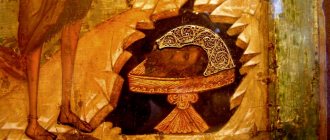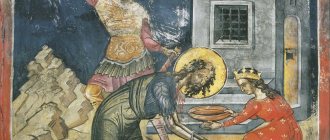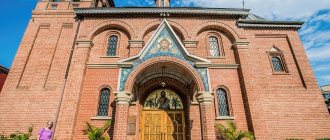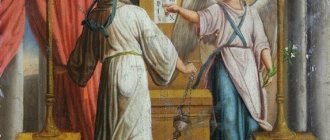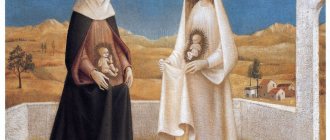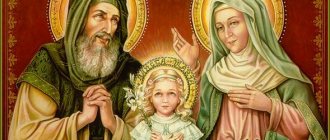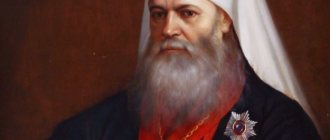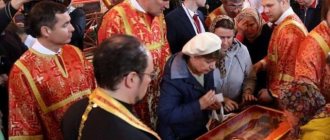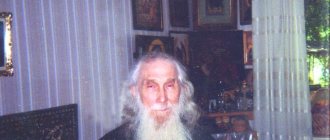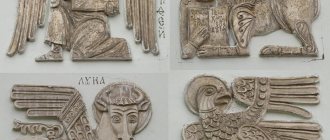"Save me, God!".
Thank you for visiting our website, before you start studying the information, please subscribe to our Orthodox community on Instagram, Lord, Save and Preserve † - https://www.instagram.com/spasi.gospodi/. The community has more than 60,000 subscribers. There are many of us like-minded people and we are growing quickly, we post prayers, sayings of saints, prayer requests, and timely post useful information about holidays and Orthodox events... Subscribe. Guardian Angel to you!
John the Baptist is the main figure of Orthodox Christianity; believers from all over the world bow before him. It was this man who laid his right hand on the Head of the Savior and completes the history of the Old Testament Church and opens the milestone of the New Testament. The miraculous face of John the Baptist is kept in the John the Baptist Convent.
- Prayer for peace of mind
Chapter of John the Baptist
Prophet John the Baptist is one of the most revered saints in Christianity. He was the last harbinger of the coming of Jesus Christ and therefore is called His Forerunner (translated from Old Slavonic - “one who walks ahead”). John also baptized the Savior in the Jordan River before the start of His public ministry. The head of John the Baptist is revered by Christians as a great shrine. After all, the Church teaches that the relics (remains) of the righteous are receptacles of Divine grace, which the saints acquired during their lifetime:
“God dwells in these bones. By him [God] they perform all miracles” (St. Ephraim the Syrian, Creations, volume 3).
Head of John the Baptist hidden in a cave
The Life and Ministry of John the Baptist
Where are the relics of John the Baptist? First of all, you should familiarize yourself with his life. This prophet lived in the early 1st century AD in Ancient Israel. He was chosen by God for a special ministry even before he was born. An angel announced to the elderly childless priest Zechariah that he would have a son, who should be named John. The future prophet became a desert hermit in his youth. Away from people, through fasting and prayer, he prepared to fulfill his calling.
At the age of 30 (from this age, Hebrew men were considered spiritually mature for mentoring), John went out to the people and began to preach. He called on his compatriots to repentance and moral improvement, and also performed baptism on them in the Jordan River. With all this, John completed the preparation of the chosen people for the coming of the Savior, begun by the Old Testament prophets thousands of years ago. Baptism in the river symbolized cleansing from sins and was a prototype of the future Christian Baptism in which the spiritual rebirth of a person occurs. John the Baptist said:
“I baptize you with water, but one mightier than me is coming, whose sandal strap I am not worthy to untie; He will baptize you with the Holy Spirit and fire” (Luke 3:16).
On the eve of His sermon, Christ Himself received baptism from John. Thus, the sinless Lord showed the greatest humility and showed how important it is to fulfill the instructions of the Almighty. The Prophet John became the first person to publicly acknowledge Jesus as the Son of God and the long-awaited Redeemer of the sins of mankind. Also, during baptism, the Holy Spirit visibly descended on Christ in the form of a dove, and the voice of God the Father was heard from heaven:
“This is my beloved Son, in whom I am well pleased” (Matthew 3:16).
Thus, by performing baptism over the Lord, the prophet John became a participant in the first appearance of the Holy Trinity in the history of the world.
Iconography
In the images, John the Baptist is depicted as a very thin man of middle age (approximately 32 years old). His Jewish-type face, dark from constant exposure to the sun, emphasizes the holiness and righteousness of the man. John's beard is medium-length, black, shaggy. The hair on the head is divided into strands. Clothes made of camel wool, tied up with a leather belt.
John's right hand is a blessing, and his left holds a scroll, which has the meaning of calling people to speedy repentance. On the man’s left shoulder there is a long Orthodox cross that looks like a staff. It means the imminent death on the Cross of the Creator of the World, Jesus Christ.
On the very first icon, painted in the 6th century, the saint was depicted alone, in full growth, in a hair shirt and with a scroll in his hand. At the top of the image, as well as on the left and right sides, there are medallions with the faces of the Mother of God and Jesus.
In the 11th century, icon painters created an image of John the Baptist, in which he is depicted bending towards Christ in prayer. He stands on the right side of the Savior. Later, icons were created where he is located on the left side of Christ.
In the 13th century, the image of the “Angel of the Desert” was painted, where the Baptist is depicted with wings. This image means that God the Father said that he was sending His Angel to earth so that he would clear the way for the Savior of the World.
Martyrdom of John the Baptist
While preaching, the prophet John fearlessly denounced stubborn sinners, among whom was the ruler of Judea. Archimandrite Alipiy (Voronov) says:
“Herod, king of Judea, took the wife of his brother Philip, Herodias, as his wife. John the Baptist denounced Herod for this illegal cohabitation. The evil Herodias harbored a grudge against the prophet of God and, wanting to destroy him, influenced the king to imprison the Forerunner.”
Once, at a royal feast, the daughter of Herodias, Salome, danced in front of the ruler and his guests. The impressed king promised to fulfill the girl’s every whim in front of everyone. Herodias told her daughter to demand the execution of John, who was imprisoned. Herod did not want the prophet to die, but did not dare to break the oath given at the feast. By order of the king, the head of John the Baptist was beheaded, which was then brought to the queen on a platter.
Tradition says that the dead lips of the righteous man continued to expose the sins of Herodias. In a fit of anger, the queen mutilated John's head and then threw it away in an unclean place. The body of the prophet by that time had already been buried by his disciples. The Monk Justin (Popovich) notes:
“The Holy Forerunner appeared in the kingdom of death and as the first Evangelist to preach the Gospel of Christ to all souls in the kingdom of death. He appeared to all of them as the first martyr to show how for the True God, the Lord Jesus Christ, the Savior of the world, people will joyfully go to death until it is defeated and trampled under foot.”
Icon of the Baptist
In the Orthodox tradition, St. John is revered first after the angelic ranks. The most famous icon in Orthodoxy is the icon called “Head on a Platter.” It depicts the truncated head of a saint with closed eyes and a halo above it. According to legend, the wicked Herodias was greatly afraid of the prophet’s resurrection, so she demanded that John’s head be buried separately from his body.
Those who seek to return to faith and repent of their sins turn to the icon of the prophet. Since the forerunner accepted the repentance of sinners and cleansed them of sins, it is to him that they turn to this request. The saint helps you find the right path in life, realize your sinful nature and gain a bright mind.
If a person is overcome by sinful thoughts, he can turn to the prophet to get rid of the trouble and temptation of the devil. The saint purifies the mind and strengthens the spirit, and also calms the rebellious heart.
They also turn to the prophet with a request to strengthen the spirit during long church fasts, because the saint ate honey and locusts all his life. He did not suffer from hunger or malnutrition and set an example of an ascetic life.
Childless couples turn to the parents of the Forerunner, who are canonized, for the gift of offspring.
Beekeepers are confident that the prophet will help them in breeding bees, since he himself ate wild honey.
First prayer to the Forerunner:
Second prayer to the Forerunner:
Head of John the Baptist: history of discovery
Many church holidays have been established in honor of John the Baptist. Some glorify the milestones of his earthly life (Conception, Nativity, Beheading of John the Baptist). Others remind Christians of significant events associated with the holy relics of the prophet. For example, there are holidays in honor of the three miraculous acquisitions of his head.
Since ancient times, the head of John has been a particularly revered shrine, because this prophet is considered by the Church as the greatest of all saints (after the Mother of God). Standing on the border of two Testaments, John became the last preparer of people for salvation in Christ. The Savior Himself said:
“Among those born of women there has not arisen a greater one than John the Baptist” (Matthew 11:11).
The head of John the Baptist is also a symbol of his steadfastness and martyrdom in the service of the Truth. The Church considers the three miraculous discoveries of this relic as a threefold victory of holiness and truth over evil and death.
According to legend, the head of John the Baptist, discarded by Herodias, was reverently buried by a secret Christian woman who was among those close to Herod. In the 4th century, a rich Christian began construction of a temple on the burial grounds of the shrine. During the work, the head of the prophet was found for the first time. The event was accompanied by miraculous signs.
After some time, the relic ended up in Syria, where it was lost again. According to God's Providence, a monastic monastery was erected on the site of the secret residence of the head. Already in the middle of the 5th century, the second miraculous discovery of the shrine took place - John the Baptist appeared to the abbot of the monastery and indicated its location. The first and second finding of the head are celebrated by the Church on March 9 (March 8 in a leap year).
The shrine was transported to Constantinople, and then, during the iconoclastic persecutions, to the city of Comana. There the head of the prophet was again lost. In the mid-9th century, the location of the relic was revealed to Patriarch Ignatius in a miraculous vision. With the participation of the Byzantine emperor, it was found for the third time and solemnly transferred to Constantinople. This event is celebrated by the Church on June 7.
News of John's conception
From history you can learn that the prophet was the son of the noble priest Zechariah and the righteous Elizabeth. According to the Evangelist Luke, Zechariah announced that his son, the Archangel Gabriel, was born, but the priest did not believe in this miracle and remained silent on this matter until the end of his days, as he showed weak faith. Elizabeth, in turn, hid her pregnancy, avoiding ridicule, although at that time her sister Anna also gave birth in old age and gave birth, among other things, to the Mother of God.
Only after the Mother of God announced the conception of the Savior, Elizabeth discovered her pregnancy and then gave birth. This event is dedicated to the icon of the Nativity of John the Baptist, which is also found in many churches. A relative of Jesus lived near Jerusalem, not far from Hebron, where his parents came from.
Head of John the Baptist in modern times
The head of John the Baptist - where is it today? In the Middle Ages, the shrine was repeatedly divided into fragments, which were scattered across many countries. Today, Christian temples and mosques (John is revered in Islam as the prophet Yahya) in Italy (Rome), France (Amiens), Syria (Damascus), Turkey (Antioch), Greece (Athos) and Nagorno-Karabakh claim ownership of pieces of the head.
In the mid-20th century, research was carried out on a fragment of the chapter (front part), which has been kept in the cathedral of the French city of Amiens for 800 years. A commission of scientific experts declared a high probability of the authenticity of the shrine. Let us quote the words of the priest-historian Timothy Katnis:
“If we are talking about the most likely location of the shrine, then this is, of course, the Cathedral of Notre Dame in France. Of all the places [where the chapter is supposedly kept], only here has a large and high-quality study of the shrine been carried out, and it is also known that this particular part of the chapter has a clear historical path.”
It is noteworthy that there is a small hole above the left eye socket of the Amiens chapter fragment. This is probably the mark of a dagger blow that Herodias struck in a fit of rage. It is known that French kings made pilgrimages to the shrine. She is also credited with saving the city from the plague in the 17th century. In the same century, Saint Demetrius of Rostov testified about the visit of Amiens by Orthodox pilgrims. Priest Maxim Massalitin notes:
“In recent years, Orthodox pilgrims have been visiting Amiens more and more often. With the participation of the Pilgrimage Center of the Korsun Diocese, Orthodox prayer services and liturgies are performed at the head of St. John the Baptist.”
What can an icon help with?
For many centuries, prayer books have asked John the Baptist:
- about a strong and happy marriage;
- about help in finding a job;
- about protection from the intrigues of colleagues and the machinations of an evil leader;
- about protection from lies and slander of enemies;
- about healing head diseases and other ailments;
- about healing thoughts;
- about choosing the right path in life.
Advice!
It is customary to give an icon of the Baptist to men who received the name John at birth or in the Sacrament of Baptism. The saint benefactors beekeepers and is considered their patron. Also, prayer in front of the icon protects against headaches.
“John the Baptist. Christmas". Temple of Veniamin of Petrograd, Moscow
Prayers to John the Baptist on the holidays of the finding of his head
On the first and second finding of the head of John the Baptist:
Troparion, tone 4
Having risen from the earth, the Forerunner's head sends forth rays of incorruption to the faithful, gathering from above a multitude of Angels, and then convenes the human race unanimously to send glory to Christ God.
Kontakion, tone 6
Prophet of God and Forerunner of grace, your head, like a most sacred thorn, having found from the earth, healing is always acceptable, for again, as before, you preach repentance in the world.
On the third discovery of the head of John the Baptist:
Troparion, tone 4
Like a Divine treasure hidden in the earth, Christ opened your head to us, prophet and Forerunner. All of us, having come together in this finding, let us sing the Savior’s hymns of God, saving us from corruption through your prayers.
Kontakion, tone 6
The luminous and Divine pillar in the world, the lamp of the sun, the Forerunner, showing his luminous and Divine head at the end, sanctifies those who faithfully worship and cry: O wise Christ to the Baptist, save us all.
Greatness for both holidays
We magnify you, John the Baptist of the Savior, and honor all your honorable achievements.
Prayer to the Prophet John the Baptist
Baptist of Christ, honest Forerunner, extreme prophet, first martyr, mentor of fasters and hermits, teacher of purity and neighbor of Christ! I pray to you, and when you come running, do not reject me from your intercession, do not forsake me, who have fallen through many sins; renew my soul with repentance, like a second baptism; Cleanse me, the sins of the defiled, and compel me to enter into the Kingdom of Heaven, even if nothing bad enters. Amen.
Read us conveniently on social networks:
Tags: head of John the Baptist, head of John the Baptist, where is the head of John the Baptist, relics of John the Baptist, beheading of John the Baptist, beheading of John the Baptist
